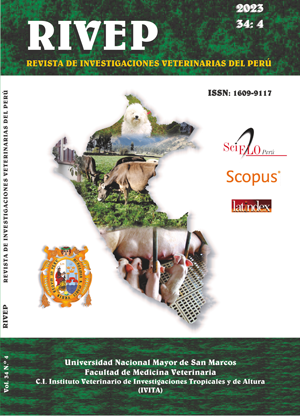Nonlinear models for the description of the growth of early culling guinea pigs (Cavia porcellus)
DOI:
https://doi.org/10.15381/rivep.v34i4.24409Keywords:
Gompertz, logistic, Von Bertalanffi, Richards, adjusted model, predictionAbstract
The aim of this study was to evaluate the non-linear Gompertz, logistic, Von Bertalanffi and Richards models to find the model that best describes the growth of early culling guinea pigs. The research was carried out in a commercial farm of Peru breed guinea pigs located in the province of Huaura, Peru. Ten males and 12 females were used, which were periodically weighed from birth to 69 days. The feeding was basically with green fodder. The degree of adjustment of the non-linear models of the weight and age of the animals was evaluated through the mean square of the error (CME) and the Akaike (AIC) and Bayesian (BIC) criteria. The logistic non-linear model was the one that best described the growth of the guinea pigs fed with green forage and allowed the elaboration of the growth standard for early culling.
Downloads
Downloads
Published
Issue
Section
License
Copyright (c) 2023 Jaime Fernando Vega-Vilca, Rufino Maximo Maguiña-Maza, Johnny Gregorio Cipriano Bautista, Claudio Andrés Vega-Cadillo

This work is licensed under a Creative Commons Attribution 4.0 International License.
AUTHORS RETAIN THEIR RIGHTS:
a. Authors retain their trade mark rights and patent, and also on any process or procedure described in the article.
b. Authors retain their right to share, copy, distribute, perform and publicly communicate their article (eg, to place their article in an institutional repository or publish it in a book), with an acknowledgment of its initial publication in the Revista de Investigaciones Veterinarias del Perú (RIVEP).
c. Authors retain theirs right to make a subsequent publication of their work, to use the article or any part thereof (eg a compilation of his papers, lecture notes, thesis, or a book), always indicating the source of publication (the originator of the work, journal, volume, number and date).










